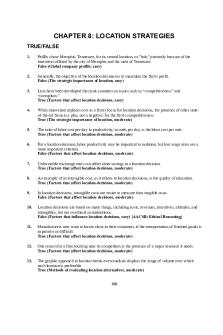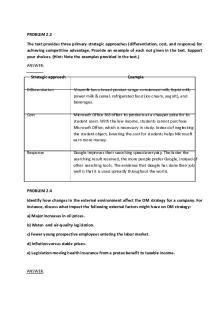Chapter 1 homework - Summary Management Principles And Practices PDF

| Title | Chapter 1 homework - Summary Management Principles And Practices |
|---|---|
| Author | Mike Langis |
| Course | Management Principles And Practices |
| Institution | Suffolk County Community College |
| Pages | 2 |
| File Size | 80.8 KB |
| File Type | |
| Total Downloads | 62 |
| Total Views | 136 |
Summary
Homework questions
...
Description
Michael Langis Bus 201 Chapter 1 1.
Describe five management competencies that are becoming crucial in today’s fastpaced and rapidly changing world.
One management competency is overseeing work. It is important to be what is called an “enabler”. Doing this helps people do and be their best. Another is accomplishing tasks. A good manager needs to be able to direct staff in an organized and productive fashion. Managing relationships in the workplace is also very important. A manager needs to be able to have a good working relationship with others through conversation and teamwork. Another competency is leadership. A key job of managers is the ability not only to set goals and standards, but the ability to evaluate the work of others. The last competency is called designing. This entails innovation, creating new methods of work, promoting creativity, and adapting to new standards. 2.
Describe technical, human, and conceptual skills and their relevance for managers.
Conceptual skill is the mental ability to see the organization as a whole and the relationship among its parts. It is the manager’s thinking and planning ability. Conceptual skills are needed by all managers, but are especially important for top managers. Human skill is the manager’s ability to work with and through other people. It is evident in how a manager relates to other people, including the ability to motivate, facilitate, coordinate, lead, communicate, and resolve conflict. Technical skill is the understanding of and proficiency in the performance of specific tasks such as engineering, manufacturing, or finance. Technical skills are most important at lower organizational levels.
3.
Define 10 roles that managers perform in organizations.
There are 3 subdivisions that the roles of a manger fall under. They are decisional, interpersonal and informational. A monitor falls under informational. This is the ability to seek and receive information. A disseminator also falls under informational. This is the ability to forward information to other organization members. A spokesperson is also an informational role. It is important to be able to transmit information to outsiders. A figurehead is someone who can perform symbolic duties such as greeting visitors and signing legal documents. Another role is being a leader. Being a leader means having the ability to direct and motivate subordinates. A liaison is another role of a manger. This means maintaining information links inside and outside the organization. Being an entrepreneur is also a role of a manger. This is inititating improvement. A disturbance handler takes corrective action during conflicts or crisis. It is very important to be able to resolve disputes among subordinates. A resource allocator decides who
gets resources. Finally, A negotiator represents team or department’s interests. All of these roles make up A manger’s responsibilities. 4. What are the basic functions of management? Planning means defining performance goals for the organization and determining what actions and resources are needed to achieve the goals. Through planning, management defines what the future of the organization should be and how to get there. Once plans are made, decisions must be made about how to best implement the plans. The organizing function involves deciding how the organization will be structured. Organizing involves assigning authority and responsibility to various departments, allocating resources across the organization, and defining how the activities of groups and individuals will be coordinated. Leaders use knowledge, character, and charisma to generate enthusiasm and inspire effort to achieve goals. Managers must also lead by communicating goals throughout the organization, by building commitment to a common vision, by creating shared values and culture, and by encouraging high performance. Controlling is the process of monitoring activities, measuring performance, comparing results to objectives, and making modifications and corrections when needed. This is often described as a feedback loop, as shown in the illustration of a product design feedback loop.
5.
When you think of today’s business environment, in your opinion, which is more important to organizations— efficiency or effectiveness? Please explain your choice.
In my opinion, effectiveness is more important than efficiency. I believe that getting the job done and getting it done well and with maximum effort is the upmost important thing. I say this because I myself am a manager at a country club. Together with my other manager, we do our best to perform our tasks and run parties to the most cost-efficient way possible. But in a field where the quality of service effects reviews, that is why I believe effectiveness is more important....
Similar Free PDFs

Davita Management Practices
- 1 Pages

Management-Concepts-Practices
- 126 Pages
Popular Institutions
- Tinajero National High School - Annex
- Politeknik Caltex Riau
- Yokohama City University
- SGT University
- University of Al-Qadisiyah
- Divine Word College of Vigan
- Techniek College Rotterdam
- Universidade de Santiago
- Universiti Teknologi MARA Cawangan Johor Kampus Pasir Gudang
- Poltekkes Kemenkes Yogyakarta
- Baguio City National High School
- Colegio san marcos
- preparatoria uno
- Centro de Bachillerato Tecnológico Industrial y de Servicios No. 107
- Dalian Maritime University
- Quang Trung Secondary School
- Colegio Tecnológico en Informática
- Corporación Regional de Educación Superior
- Grupo CEDVA
- Dar Al Uloom University
- Centro de Estudios Preuniversitarios de la Universidad Nacional de Ingeniería
- 上智大学
- Aakash International School, Nuna Majara
- San Felipe Neri Catholic School
- Kang Chiao International School - New Taipei City
- Misamis Occidental National High School
- Institución Educativa Escuela Normal Juan Ladrilleros
- Kolehiyo ng Pantukan
- Batanes State College
- Instituto Continental
- Sekolah Menengah Kejuruan Kesehatan Kaltara (Tarakan)
- Colegio de La Inmaculada Concepcion - Cebu













